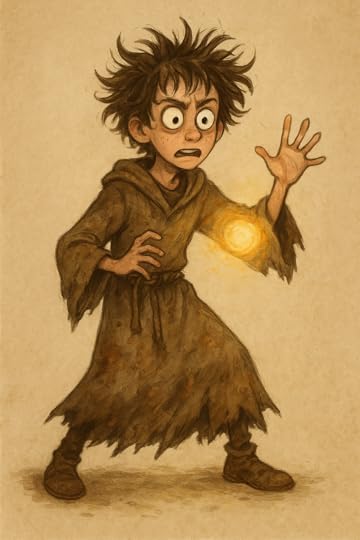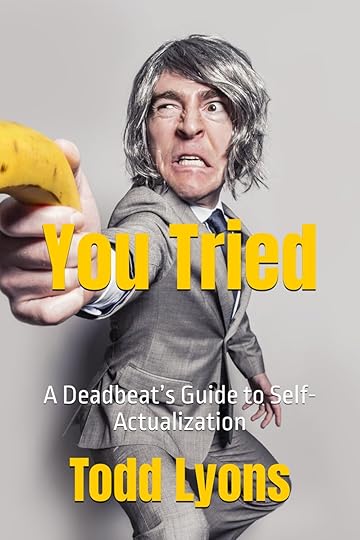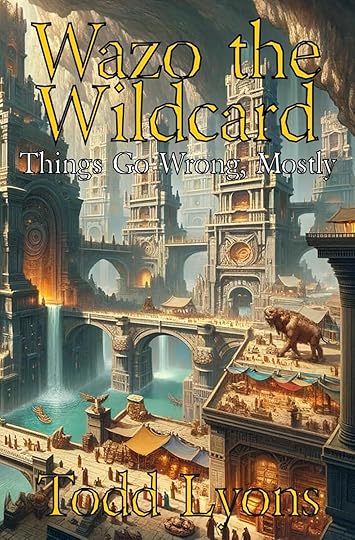Todd Lyons's Blog
September 25, 2025
"Wazo the Wildcard: Things Go Wrong, Mostly" is Released
August 21, 2025
Wazo the Wildcard (or: What I Did On My Summer Vacation)
So, while you were busily doing nothing or lazing on a beach somewhere, some of us were not doing that but wishing we were. Unfortunately, we were stuck doing regular maintenance on our 130 year old house. Well, I was, anyway. And I really don't enjoy working with my hands; it makes my brain scream out for distraction.
As it turns out, that's a great way to inspire another book.
And that book will be out later this year, I hope. It stars someone you might remember from Chrysogon’s Coterie, though for most readers, Wazo will be brand new...
...which is probably for the best, because Wazo… well... he sees the world sideways, and not always the same sideways twice.
He’s the sort of person who can fall into an open pit trap and call it “a tactical choice.” Someone who takes a mysterious, possibly malevolent stone at its word, even as it ruins his day. A guy who argues with reality like it owes him money.
Wazo is messy, brilliant in short bursts, prone to enthusiasm at very bad times, and loyal in a way that terrifies his enemies and occasionally his friends. He is either the worst hero you could ask for, or the best one you’ll get under the circumstances.
The book’s called Wazo the Wildcard: Things Go Wrong, Mostly. It’s funny until it isn’t, then funny again, because life works like that. Or mine does, anyway. When it works.
If you liked You Tried and want something lighter, I think you'll like it.
If you didn't like You Tried and wanted to give me another chance (please), I think you'll like it.
More soon.

What I Did On My Summer Vacation
So, while you were busily doing nothing or lazing on a beach somewhere, some of us were not doing that but wishing we were. Unfortunately, we were stuck doing regular maintenance on our 130 year old house. Well, I was, anyway. And I really don't enjoy working with my hands; it makes my brain scream out for distraction.
As it turns out, that's a great way to inspire another book.
And that book will be out later this year, I hope. It stars someone you might remember from Chrysogon’s Coterie, though for most readers, Wazo will be brand new...
...which is probably for the best...
...because Wazo… well... he sees the world sideways, and not always the same sideways twice.
He’s the sort of person who can fall into an open pit trap and call it “a tactical choice.” Someone who takes a mysterious, possibly malevolent stone at its word, even as it ruins his day. A guy who argues with reality like it owes him money.
Wazo is messy, brilliant in short bursts, prone to enthusiasm at very bad times, and loyal in a way that terrifies his enemies and occasionally his friends. He is either the worst hero you could ask for, or the best one you’ll get under the circumstances.
The book’s called Wazo the Wildcard: Things Go Wrong, Mostly. It’s funny until it isn’t, then funny again, because life works like that. Mine does, anyway. When it works.
If you liked You Tried and want something lighter, I think you'll like it.
If you didn't like You Tried and wanted to give me another chance (please), I think you'll like it.
More soon.

July 4, 2025
A Book That Grows With Me: Why I Embrace Silent, Slow Updates

When I first set out to write You Tried, I didn’t want to create a static artifact—a final, unchanging object sealed in amber. Instead, I wanted the book to be a living reflection of me: messy, neurodivergent, and always evolving.
You might notice subtle changes in the text over time—a sentence reworded here, a tiny addition there, a joke sharpened or a thought deepened. These tweaks aren’t bugs or mistakes; they’re part of the journey. They’re like emotional software updates, silent and slow, sometimes imperceptible if you were to compare versions published weeks apart, but unmistakable once you look back over months or years.
This approach is very different from how I work on my open-source Basic Fantasy RPG books, which use numbered releases and forum posts acting as changelogs. But this book is personal, and I want its changes to mirror me—gradual, quiet, and organic.
After making many tweaks during the book's first few week's of life, I added this paragraph to Appendix J:
Stealth Update Advisory
Please be aware that the author cannot be trusted not to tweak, revise,
or impulsively expand this manuscript during routine proofreading.
This is not a bug. It’s a compulsion.
Every time a typo gets fixed, new content sneaks in. The book now
exists in multiple parallel versions, all equally canonical, none officially
numbered. Like emotional software updates, you won’t notice what
changed—only that you feel slightly different afterward.
This advisory was added during one such update.
I trust my readers enough to come along for this ride—to embrace the imperfections, the slips, the expansions, and even the small mysteries of “Did that line sound different before?” Because the truth is, none of us are fixed or finished. We’re all works in progress.
So if you’re reading this book now, or years from now, know that you’re holding something that will be alive so long as I am. And that, to me, is exactly how it should be.
Amazon CanadaAmazon USJune 19, 2025
19 Years in the Making, "You Tried" is Now Released

What? A real book. One that the average person might actually buy?
Yes. I’m still shocked too.
This manuscript started life 19 years ago as an escape. A coping mechanism. Then I stopped believing in my writing and quit. The bleakness of the COVID-19 lockdown made me start again. I wrote a couple of self-published TTRPG books, thinking they were a safe way to practice writing again. Fiction, mostly. Maps and monsters. Not personal. But even as I wrote those, I could tell how much of my unresolved pain was seeping in. 'Chrysogon’s Coterie' contains a lot of me—splintered into dozens of characters, some noble, some petty, all carrying too much. That book revealed things I wasn’t ready to face. But I kept writing. By the time my second book came out, I’d already finished a third. And was halfway through a fourth. Then I stopped again. Because I realized how much of what I write still comes from the same places: anxiety, anger, depression, insecurity. I decided to revisit the book I never finished. The one I abandoned before any of the others. I did. And this is it. It’s not the same book it was back then. I’ve had almost 20 more years of wrangling my demons. The anger’s softened. The bitterness too. It’s easier for me to read now. Less painful to write. But I didn’t expect it to be quite so... listy. If you notice a heavy reliance on lists, please know that wasn’t a stylistic decision so much as a survival strategy. Lists are how I think. They keep me organized. Help me remember the things I forget. They’re also how I avoid thinking too hard. They got me through the days when writing paragraphs was too much and coherence felt like a myth. Lists trick my brain into believing it’s being linear, even when it’s just pacing in a circle. Also: prose is hard. Bullet points are shaped like soft little shields. If you’re neurodivergent, overwhelmed, emotionally exhausted, or just short on dopamine—this book is for you. If you’re not? This book is still for you. You might just need to squint in sympathy.Amazon CanadaAmazon USMay 31, 2025
Nightmare Voyager Cover Reveal
 Here's an early preview of the cover of my forthcoming 3rd book Nightmare Voyager. The artist is M. W. Byouk, who I long admired before reaching out. He has also created a dozen pieces of interior art for the story's characters, and says there are more to come. I can't recommend him highly enough.
Here's an early preview of the cover of my forthcoming 3rd book Nightmare Voyager. The artist is M. W. Byouk, who I long admired before reaching out. He has also created a dozen pieces of interior art for the story's characters, and says there are more to come. I can't recommend him highly enough.
May 15, 2025
7 Tips for Writing for the Post-Truth World

During recent elections, platforms like YouTube were swarmed by coordinated bot campaigns targeting centre-left candidates—part of a tactic known as astroturfing, designed to fake public consensus. The election is over, but the misinformation never stops. Every day, I’m reminded that in a world of “alternative facts,” misinformation, factional loyalty, and algorithmic echo chambers continue to erode rational discourse.
Communicating effectively in this environment takes more than good intentions—it demands clarity, empathy, credibility, and a sharp understanding of how narratives work. For my own reference, and hopefully yours, here are 7 key strategies for writing social media posts that are more resonant, resistant, and real.
1. Prioritize Clarity Over Complexity
2. Frame Narratives, Not Just Facts
3. Anticipate Misinformation—and Prebunk It
An average user scrolling YouTube during the election might have thought, ‘Wow, everyone hates this candidate,’ when in fact many of those comments came from fake accounts posting on scripts—designed to create that exact illusion. So:
4. Build Trust With Tone and Sourcing
5. Make the Reader Feel Empowered, Not Defeated
6. Platform-Specific Adaptation
7. Accept You Won’t Win Everyone
Truthful communicators don’t claim to be all-knowing or perfectly neutral; instead, they acknowledge uncertainty, embrace complexity, and welcome scrutiny. In responsible hands, introducing facts alongside thoughtful skepticism of misinformation acts more like a vaccine than a virus—it builds resistance to bad info instead of helping it spread.
April 30, 2025
What's not to love?
My second book received a rather scathing review by a well respected but infamously irascible critic. I generally avoid reading his work because it skews so negatively and attracts a fair share of trolls, but I made an exception.
 "This is from another time…" he suggests, "and not a good one."
"This is from another time…" he suggests, "and not a good one."
I am 55 years old and played 1st Edition AD&D and 1981 BX when they were new. Admittedly, I write in a style out of time. People who prefer OSR to actual Old School would do well not to read my previous book or the forthcoming one. I write dramatically, include DM commentary, and love lore-dense lead-ins in the style of late 70s to mid 80s TSR.
I use a conversational tone. Perhaps you'll appreciate it, maybe you'll hate it. "There is, I guess, no accounting for taste," the critic says. Trite and true.
Spire does have a significant lore section, but not excessive. For example, it's half as long as
ASE1: Anomalous Subsurface Environment. ASE1 definitely does a better job of linking lore to actions in the dungeon. This is as it should be. It's an adventure for character levels 1-2 and it would be a challenge for an inexperienced GM to pull efficiently from ~40 pages of preface on the fly.Spire presumes that a GM running a mid-level adventure would appreciate less load up front and more agency within the module. It describes the sentient weapons and includes rollable tables for the wandering monsters, the NPCs, and the rumours. But it's a source book, not a cookbook. There are ingredients, but it falls to the GM to decide how they come together as the dungeon unfurls. So much has to do with player decisions.
Sure, I could have made it very prescriptive from start to finish. No. The first book wasn't that either. It was 288 vignettes of people at various points in their lives. Take the material and run with it. Make it your own.
Anyway. Free book. One troll commented that it might be overpriced. Be warned, I guess.
April 6, 2025
Beneath the Silver Spire is the #1 New Release
When Chrysogon's Coterie became a #1 new D&D release on Amazon, I was shocked. Now with my second book, I'm pleasantly surprised. I hoped for a good reception, but you never know.
Beneath the Silver Spire, my first adventure module for the Basic Fantasy Role-Playing Game (BFRPG), has catapulted to the #1 position! Better still, my friend Chris Gonnerman's book has climbed to number 3. Both books were part of an Easter Release for the BFRPG project.
Thanks to Chris, Ender, Alan, James, and everyone else in the community who support my work. I could never do this alone.
Basic Fantasy RPG is an open source tabletop RPG which is compatible with old-school TSR-era Basic & Expert Dungeons & Dragons, circa 1981. That said, you could use this adventure with your fantasy retroclone of choice, with only minor modifications.
Amazon US: https://www.amazon.com/dp/B0F3NGQYP2
Amazon Canada: https://www.amazon.ca/dp/B0F3NGQYP2
Other countries, search for product B0F3NGQYP2
Lulu US: paperback
Lulu US: coilbound
DriveThruRPG: softcover or free PDF
April 4, 2025
Beneath The Silver Spire Print Release
Cover illustration by S. Ender Thiel
Beneath The Silver Spire, my second book and first adventure module for the Basic Fantasy Role-Playing Game (BFRPG), is now available in print!
Amazon US: https://www.amazon.com/dp/B0F3NGQYP2
Amazon Canada: https://www.amazon.ca/dp/B0F3NGQYP2
Other countries, search for product B0F3NGQYP2






